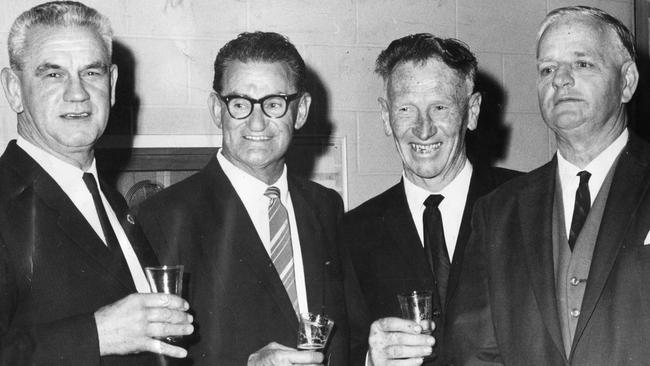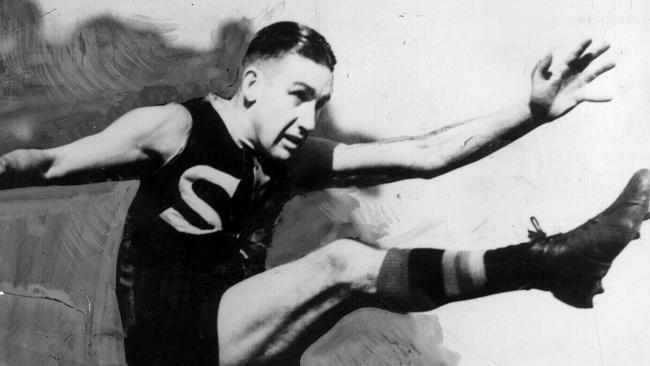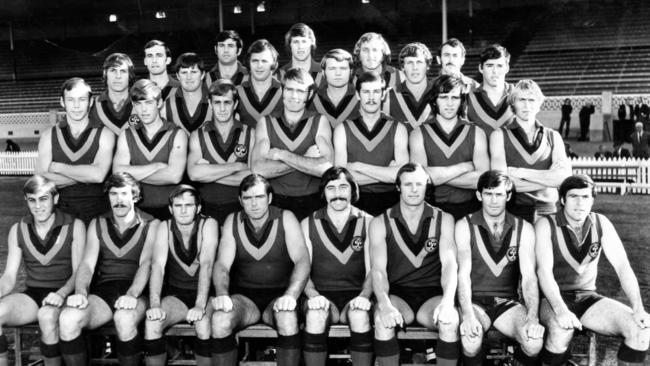So much has changed in a century but memories of footy heroes long gone remain
The start of a new decade is a time to look forward but also a time to take stock of how far we have come – and a single black and white photo has given Graham Cornes pause for thought.
Graham Cornes
Don't miss out on the headlines from Graham Cornes. Followed categories will be added to My News.
Who doesn’t like old photos of footy teams? There is no better reminder of the history and the heritage of Australian football.
The most interesting sporting photo published this week accompanied the Advertiser.com.au article by Jack Hudson about football in the 1920s. One hundred years ago! Football in the 1920s would otherwise have been forgotten – buried only in some archive – save for photos.

The photo of the 1928 South Australian state team is fascinating. It’s a black and white photo of strong, serious, determined looking young men in jumpers that look more like South Adelaide’s than the traditional South Australian guernsey.
Watch over 50 sports LIVE on Kayo! Stream to your TV, mobile, tablet or computer. Just $25/month, cancel anytime. New to Kayo? Get your 14-day free trial & start streaming instantly >
In an era before weight-training the images are of strong, fit young men whose bodies are honed and hardened by their working-class occupations.
They are of course young men but what is it about old team photos that ages them? Looking at that photo they could just as easily be in their forties as their twenties. Unfortunately only three names accompanied the photo: Bruce McGregor, who was captain, Walter Scott (who was known as either “Wat” or “Wacca”) and Horrie Riley. Who are the others?
The photo is nearly 100 years old but incredibly, I recognised others that I had met and been inspired by.

One hundred years seems such a long time but remarkably we are connected. Who could have thought? Bruce McGregor is unmistakeable. A handsome man with a full head of hair, he had been a West Adelaide champion but he coached Glenelg to the club’s first premiership in 1934.
He only played 102 games for Westies but won two Magarey Medals. He addressed our Glenelg team at a dinner before the 1973 grand final – an older man by then but still with the presence of a champion.
The other two Glenelg champions stand tall in the back row of that photo. Jim Handby and George “Blue” Johnston both won the Magarey Medal. Young Glenelg players of the 70s regarded them with awe. “Wacca” Scott introduced himself to me one night at a Magarey Medal dinner.
An instantly likeable bloke, he had won three medals – in 1921, 1924 and 1930. An undoubted champion of the game he is in the Australian Football Hall of Fame – posthumously.
Strangely, McGregor and Johnston are not. What happens to the contributions of these players who stare seriously from these old photos? It’s a vexing question. Could they have had any idea how far the game has come?
What would they have said if someone had told them that in the year 2020, football would be a full time profession and some players would earn over a million dollars a year? Young players of today may not realise it, but they have an enormous debt of gratitude to those who have passed before them.

Each decade had its champions. One hundred years ago, in the 1920s it was McGregor, Scott and a smallish South Adelaide defender, Dan Moriarty who won the Medal three times.
The 1930s were dominated by North Adelaide’s goalkicking phenomenon, Ken Farmer, but a champion Port Adelaide rover, Bob Quinn emerged before World War Two erupted.
The 1940s was a fractured decade for football as the country rebuilt after the war. Bob Quinn returned from active service, wounded and decorated, to win another Magarey Medal but the star of the decade was West Torrens champion, Bob Hank.
I had a personal favourite in Allan Crabb – a decorated, returned airman who won the Medal in 1949. Unfortunately it was awarded posthumously. He had lost it in a countback at the time but eventually the rules changed.
He deserved to know he had won it, though given what he had experienced in the Battle of Britain, I doubt it would have been of much concern to him.
The fifties were a glorious era for footy with great names emerging. A baby-faced champion, Lindsay Head, starred for West Torrens, but there were other stars: Kerley, Williams, Fitzgerald, Deane.
The sixties were dominated by Port Adelaide and Sturt. Geoff Motley, John Cahill, Paul Bagshaw and John Halbert were the stars but Jack Oatey and Neil Kerley made big impacts as coaches.
There has never been better decade of football than the 1970s. There are so many legends. Robran, Ebert and Blight tower over the decade but there are other great names: Davies, Carey, Carman, Sewer, Taylor.
Football started to change in the 1980s. A new professionalism impacted the game as fitness levels, strength and skills all improved. Greats of the game were nurtured in the SANFL. Platten, Kernahan, McDermott, Naley, McIntosh, McGuinness, Andrew Jarman and Peter Motley before his accident, were genuine champions of football.

South Australian football fractured in the 90s as the VFL morphed into the AFL and devoured the football states.
But we still had our South Australian champions. Tony Modra, Darren Jarman, Andrew McLeod, Mark Ricciuto, Ben Hart, Warren Tredrea, Mark Bickley, Shaun Rehn became household names but our best players started to make their names in other football states.
It got worse in the new century. 2000-2010 saw the state’s best players drafted interstate but the names don’t seem to have the same impact. Pavlich, Burgoyne, Mackie, Lake, Hurn were great players and Adam Cooney won a Brownlow Medal but it just doesn’t seem the same. Magarey Medal winners are good players but how can you compare the name O’Connor to Ebert?
It’s been much the same in this past decade, 2010 – 2019. The household names here in South Australia play for the Crows or Port. However Robbie Grey and Travis Boak are Victorian; so is Rory Laird.
They say football in 2020 is unrecognisable to the game that was played 100 years ago. That may be true but there are similarities. We still play footy at Adelaide Oval and Alberton. The grounds are still oval-shaped with goal and behind posts.
There are still 18 men on the field. But how, in this digital age that Bruce McGregor or Wacca Scott could not have imagined, will we preserve today’s game for posterity? It may be some fanciful holographic imagery of a technology yet to be developed or they may run and leap from a virtual football field.
However we could never love it like we love those old footy team photos.
